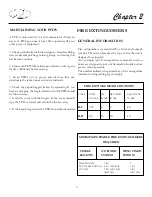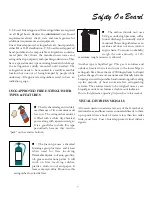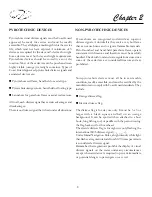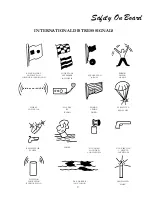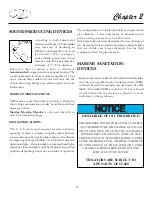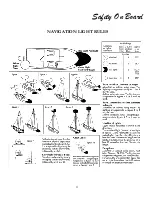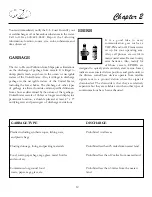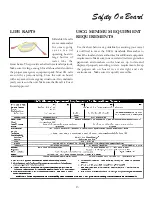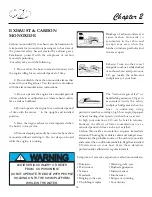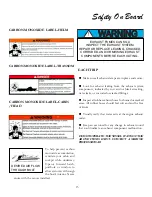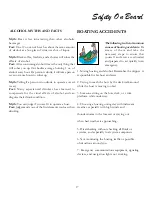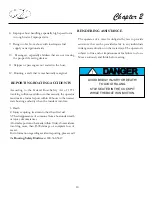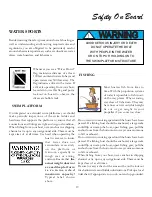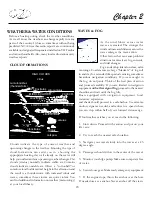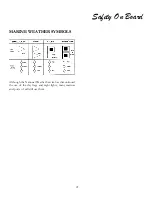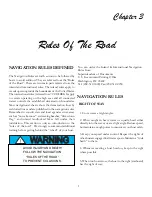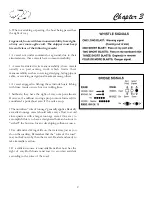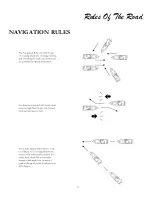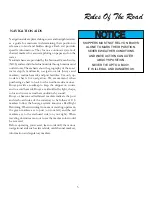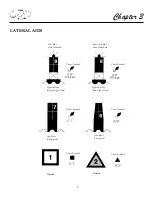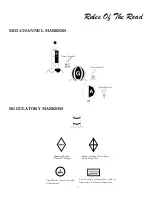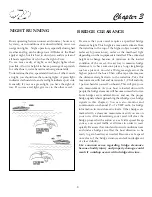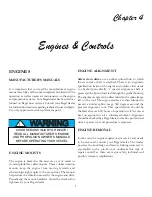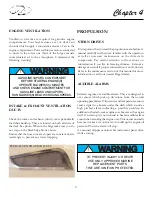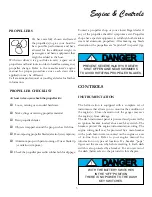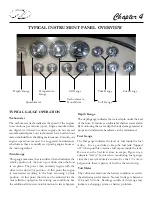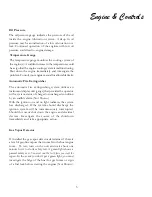
20
Chapter 2
WEATHER & WATER CONDITIONS
Before a boating outing check the weather conditions.
As we all know the weather can change rapidly in many
parts of the country. It does so sometimes without being
predicted. NOAA weather radio reports are continuously
available on designated frequencies installed on VHF radios
and various handhelds. Also, many local radio stations carry
weather reports .
CLOUD FORMATIONS
20,000 Ft.
6,500 Ft.
HIGH CLOUDS
MIDDLE CLOUDS
LOW CLOUDS
catspaw
nibostratus
stratus
cumulus
stratocumulus
cumulonimbus
(thunderstorm)
cirrus
cirrostratus
cirrocumulus
altostratus
altocumulus
As the wind blows across water
waves are created. The stronger the
wind and increased distance across the
water enlarges the wave action.
Other factors that can cause problem
situations for vessels are fog, currents,
and tidal changes.
Fog can develop inland on clear, calm
mornings. Coastal areas see large “blankets” of fog roll
in and stay for extended time periods causing sometimes
hazardous navigation conditions. If you are caught in
the fog, do not panic. Think of the best plan of action
and proceed carefully. If you are limited in navigation
equipment
at the first sign of fog
proceed to the nearest
shoreline and wait until the fog lifts.
Boats equipped with navigation equipment, local
waterway experience
and charts should proceed to a safe harbor. Use extreme
caution, signal as needed, and reduce to a speed where
you can stop within half of your forward vision range.
If foul weather catches you at sea do the following:
1. Slow down. Proceed with caution and put on your
life vests.
2. Try to reach the nearest safe shoreline.
3. Navigate your vessel slowly into the waves at a 45
degree angle.
4. Passengers should sit low in the center of the vessel.
5. Monitor your bilge pump. Make sure sump stays free
of water.
6. Secure loose gear. Make ready emergency equipment.
7. If the engine stops, throw the anchor over the bow.
If needed use a sea anchor. Never anchor off the stern.
WAVES & FOG
Clouds indicate the type of current weather and
upcoming changes in the weather. Knowing the type of
cloud formations can assist you in choosing the
appropriate boating day or if already on the water will
help you understand any upcoming weather changes. Flat
clouds (stratus) normally indicate stable air. Cumulus
clouds indicate unstable air. Often a “cottonball” or
cumulus cloud builds vertical height in the afternoon and
the result is a thunderstorm with increased winds and
waves; sometimes these storms are quite violent. You
can find additional information on weather (meteorology)
at your local library.
Summary of Contents for 30 EXPRESS
Page 1: ...30 EXPRESS OWNER S MANUAL...
Page 2: ...784022 OWNER S MANUAL 30 EXPRESS 12 2012...
Page 30: ...11 Safety On Board NAVIGATION LIGHT RULES...
Page 41: ...Chapter 2 22 Notes...
Page 44: ...3 Rules Of The Road NAVIGATION RULES...
Page 85: ...28 Chapter 5 Notes...
Page 105: ...4 Chapter 7...
Page 106: ...5 Equipment Operation...
Page 107: ...6 Chapter 7...
Page 108: ...7 Equipment Operation...
Page 109: ...8 Chapter 7...
Page 110: ...9 Equipment Operation...
Page 111: ...10 Chapter 7...
Page 117: ...16 Chapter 7...
Page 126: ...25 Equipment Operation ROTARY ENCODER AND MENU KEY...
Page 127: ...26 Chapter 7 USING THE ROTARY ENCODER AND MENU KEY...
Page 158: ...57 Equipment Operation BACKING A TRAILER 1 2 3 4 LAUNCHING RAMP...
Page 161: ...60 Chapter 7 Notes...
Page 195: ...34 Chapter 8 Notes...
Page 204: ...9 Troubleshooting TOILET SYSTEM DIAGNOSTIC CHART...
Page 209: ...14 Chapter 9...
Page 219: ...6 Chapter 11 Notes...
Page 221: ...2 Chapter 12...
Page 224: ...5 Technical Information 30 Express Deck Overview 30 Express Cabin Overview...
Page 225: ...Technical Information 12 6 30 EXPRESS...
Page 226: ...12 7 Technical Information 30 EXPRESS...
Page 227: ...Technical Information 12 8 30 EXPRESS...
Page 228: ...12 9 Technical Information 30 EXPRESS...
Page 229: ...Technical Information 12 10 30 EXPRESS 30 EXPRESS...
Page 230: ...12 11 Technical Information TYPICAL NEGATIVE GROUND SYSTEM...
Page 231: ...Technical Information 12 12 30 EXPRESS...
Page 232: ...12 13 Technical Information 30 EXPRESS...

